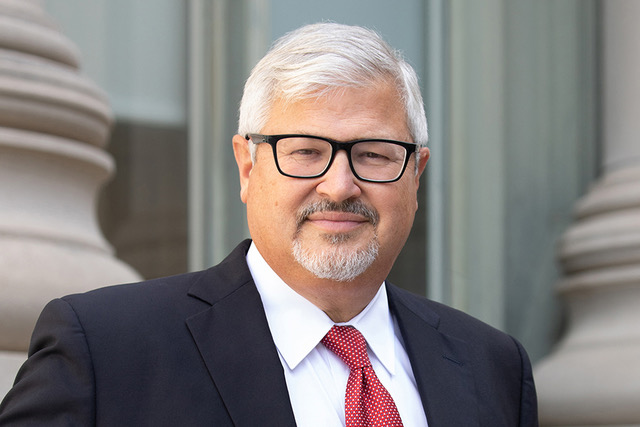The U.S.-Ukraine Agreement: Legality and Transparency
The recently announced mineral deal is likely a lawful “sole executive agreement” that the president need not submit to Congress, but subsequent implementing agreements are likely to raise questions of legality and transparency.

Published by The Lawfare Institute
in Cooperation With

Editor's note: This piece was cross-posted at Just Security.
On April 30, the United States and Ukraine signed an agreement “on the Establishment of a United States-Ukraine Reconstruction Investment Fund” that concerns the sharing of revenues from the future extraction of Ukraine’s mineral and energy resources. Ukraine’s Minister of Economy announced the day the agreement was signed that it “will be submitted to the Verkhovna Rada [Ukrainian Parliament] for ratification.” But the United States has expressed no such plans for its own legislature.
In this post, we explain why we believe that the agreement is likely a lawful “sole executive agreement” that the president need not submit to Congress and then analyze the relevance of recent reforms to the Case-Zablocki Act for the transparency of the agreement and an important related agreement that is being negotiated pursuant to it.
Terms of the Agreement
Although the United States has not released a copy of the agreement, Ukraine has done so. It calls for the United States and Ukraine to establish a Reconstruction Investment Fund in the form of a limited partnership. The details of the fund agreement are being negotiated separately as part of what is referred to as the “LP Agreement” (“LP” is for “Limited Partners”). The LP Agreement will be concluded between a U.S. government agency, the United States International Development Finance Corporation, and a Ukrainian agency.
The United States and Ukraine will each make contributions to the fund “in accordance with the terms of the LP Agreement.” The agreement further states that the value of any future military assistance that the United States provides to Ukraine will be treated as U.S. contributions to the fund. The agreement does not, however, obligate Ukraine to reimburse the United States for prior military support.
The U.S.-Ukraine partnership that administers the fund will issue licenses and special permits for resource extraction in Ukraine subject to revenue sharing arrangements. The United States and its designees are expressly allowed “to negotiate for, in accordance with the terms of the LP Agreement, offtake rights on market-based commercial terms during the term of such license or special permit.” This will potentially give the United States access to rare earth minerals and other resources, which the Trump administration has indicated is one of its goals in making the agreement. The agreement recognizes, however, that “Ukraine has, in accordance with international law, sovereignty over its natural resources located in its territory as well as in its territorial waters.”
The United States makes no security guarantees in the agreement, and, more generally, makes little in the way of firm commitments in it (more on this below). The chief benefit of the agreement to Ukraine comes not from any U.S. concessions but rather from the fact that it gives the United States a continuing stake in Ukraine’s survival and prosperity. The agreement appears to envision that such a stake could be longstanding: It does not specify an end date or permit unilateral withdrawal but instead states that it shall remain in force “until such time as the Parties agree to its termination.”
In a fact sheet relating to the agreement, the White House emphasized this point, stating that “this partnership sends a strong message to Russia—the United States has skin in the game and is committed to Ukraine’s long-term success.” Consistent with this idea, the agreement says that the parties view it as an “expression of a broader, long-term strategic alignment between their peoples and governments, and a tangible demonstration of the United States of America’s support for Ukraine’s security, prosperity, reconstruction, and integration into global economic frameworks.”
The fact sheet contains additional language that is likely to be heartening to Ukraine, referring, for example, to “the large-scale destruction caused by Russia’s full-scale invasion.” It also makes clear that “[n]o state, company, or person who financed or supplied the Russian war machine will be allowed to benefit from the reconstruction of Ukraine, including participation in projects supported by fund resources.”
Sole Executive Agreement?
The agreement says that it will enter into force after “each Party has completed its internal procedures for entry into force.” For Ukraine, the agreement “requires the ratification of this Agreement by the Verkhovna Rada [Parliament] of Ukraine.” But there is no sign that the Trump administration plans to seek the consent of Congress or the Senate. That raises the obvious question: Under what domestic legal authority can the president conclude the agreement?
As we have explained at length in prior work, under the U.S. Constitution, the president can lawfully make an agreement without congressional consent if it is a nonbinding agreement (i.e., one not governed by international law) or if it is a binding agreement that falls within the president’s constitutional authority to make sole executive agreements. We believe that the agreement falls into the latter category.
The agreement is governed by international law because it includes commitments that are clearly intended to bind the parties. Yet these binding obligations are largely one-sided. The agreement specifies many binding obligations for Ukraine (e.g., “The Government of Ukraine shall take all steps to empower its agencies and instrumentalities to execute and implement this Agreement . . . .”).
By contrast, the only binding obligations on the United States that we can discern concern non-substantive matters relating to consultation, negotiation, and interpretation. For example, the agreement states that “the Parties shall consult and negotiate in good faith . . . .” and that “the Parties shall endeavor to agree on the interpretation and application of this Agreement and shall make every attempt through cooperation and consultations to arrive at a mutually satisfactory resolution of any matter that might affect its operation.”
The other obligations that the United States assumes in the agreement appear to be nonbinding. Article II, for example, states that “it is the policy of the Parties to have the United States International Development Finance Corporation [and its Ukrainian counterpart] . . . conclude [the aforementioned LP Agreement]” (emphasis added). The United States also “affirms that it has put in place the necessary measures . . . to execute and implement this Agreement and the LP Agreement.” No new measures, this seems to assert, are needed. Throughout the Agreement, the United States “affirms” and “expresses its expectation,” but does not commit to new binding obligations beyond the non-substantive ones noted above.
In sum, the arrangement imposes legal obligations on both parties, which makes it a binding agreement under international law, even though many of the provisions—including nearly all those pertaining to the United States—are nonbinding. Notably, the obligations assumed by the United States—consultation, negotiation, and interpretation—all appear to fall within the president’s powers over diplomacy and related matters and can thus be made by the president under Article II without congressional consent. Because the agreement does not appear to create binding obligations on the United States that require congressional consent, we conclude that the administration likely has the authority to conclude it as a sole executive agreement.
That said, the agreement envisions the negotiation of additional agreements, including the LP Agreement, that may require congressional authorization or approval. If obligations or entitlements addressed in the additional agreements concern matters that are not within the president’s independent authority and are not within the scope of a prior congressional authorization, the agreements would need to be submitted to Congress or the Senate for approval. It would not matter if these additional agreements were authorized by the initial U.S.-Ukraine agreement, since a sole executive agreement cannot validly authorize presidential actions that fall outside of the president’s independent authority.
Transparency Requirements
In December 2022, Congress revised the 1972 Case-Zablocki Act to impose new transparency requirements on international agreements made by the executive branch. (We previously discussed the statute here and here.) Under these rules, the executive branch is required to disclose to Congress and to publish certain binding and nonbinding executive agreements within specified time periods.
As an “international agreement” within the terms of the Case-Zablocki act, the U.S.-Ukraine Agreement is subject to its reporting and publication requirements. Because Ukraine has made the agreement public, these transparency requirements are less critical than they might otherwise be. The revised rules do require the executive branch not only to disclose the text of the agreement but also to offer a “detailed description of the legal authority” that provides support for the agreement. That would be helpful here, as it would clarify whether the agreement is being concluded as a sole executive agreement instead (for example) on the basis of a prior congressional authorization—and, if the latter, which statutes the executive branch believes authorize the agreement. Ukraine’s disclosure does not absolve the executive branch of its legal obligation to observe these requirements.
The transparency requirements could become even more important when it comes to the LP Agreement. That agreement is subject to the same transparency requirements—and thus must be reported to Congress and published. Perhaps Ukraine will again make the agreement public. After all, much of the value of the agreement to Ukraine is the public show by the United States of a long-term investment in Ukraine. But the American public should not have to rely on a foreign partner to publish the agreement in order to learn what commitments the executive branch has made on the United States’ behalf. (As we recently discussed, this concern about transparency also applies to an agreement that the administration has made with El Salvador concerning the detention of migrants—an agreement that is highly relevant to pending litigation but that the administration is trying to keep secret.)
The ability to conclude some agreements without seeking the Senate’s or Congress’s approval has given the executive branch valuable flexibility in international relations. The transparency requirements that Congress has imposed to ensure some degree of accountability for these and other agreements have not always worked as they should—and we have long advocated improvements, many of which were made by Congress in 2022. Some have questioned whether these transparency requirements are worth the trouble—after all, many agreements concluded by the executive branch provide for run-of-the-mill cooperative endeavors that are unlikely to trigger objections. The recent decisions by the Trump administration to use such agreements to make major foreign policy commitments on behalf of the United States confirm the importance of these transparency rules.







